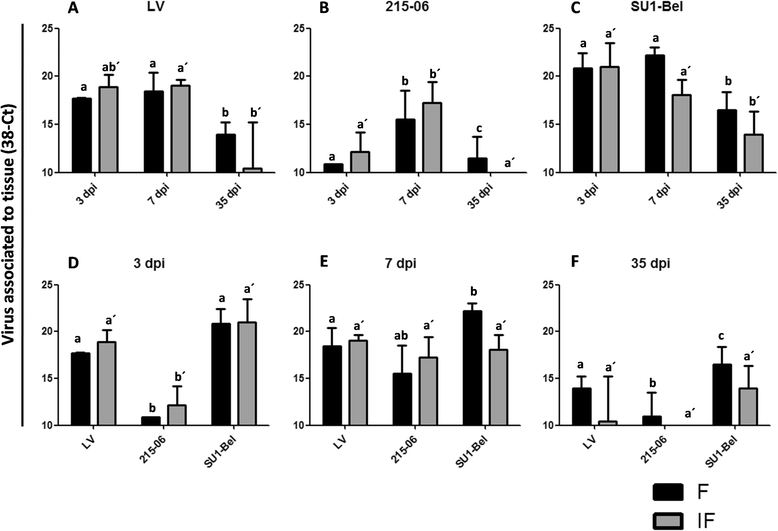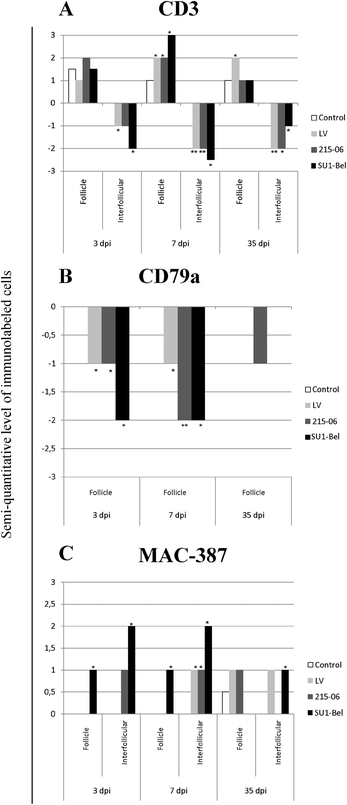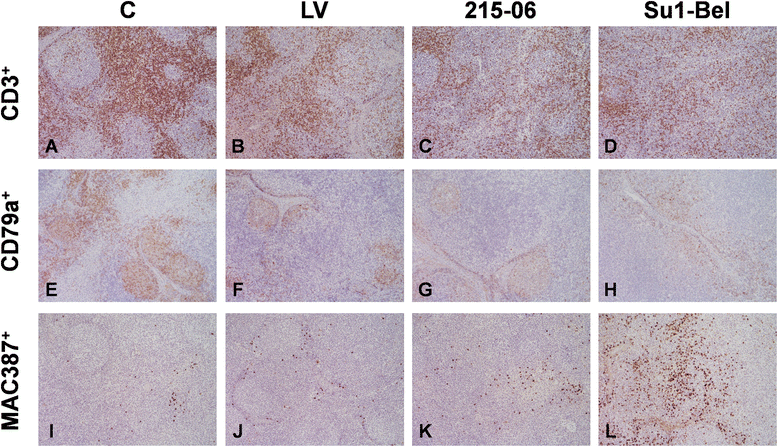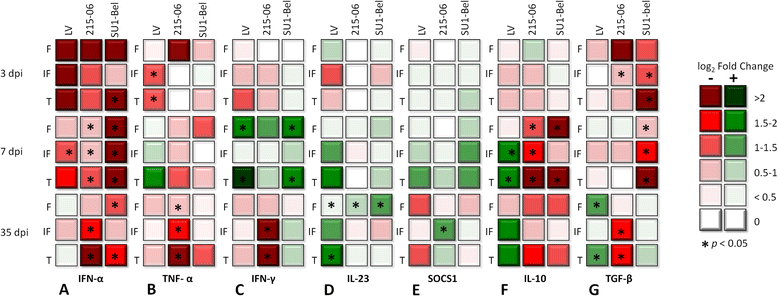Comparative analysis of cytokine transcript profiles within mediastinal lymph node compartments of pigs after infection with porcine reproductive and respiratory syndrome genotype 1 strains differing in pathogenicity
- PMID: 25889072
- PMCID: PMC4364558
- DOI: 10.1186/s13567-015-0161-8
Comparative analysis of cytokine transcript profiles within mediastinal lymph node compartments of pigs after infection with porcine reproductive and respiratory syndrome genotype 1 strains differing in pathogenicity
Abstract
Porcine reproductive and respiratory syndrome virus (PRRSV) induces a weak immune response enabling it to persist in different organs of infected pigs. This has been attributed to the ability of PRRSV to influence the induction of cytokine responses. In this study, we investigated the cytokine transcriptional profiles in different compartments of the mediastinal lymph node of pigs infected with three genotype 1 PRRSV strains of differing pathogenicity: the low virulence prototype Lelystad virus (LV), and UK field strain 215-06 and the highly virulent subtype 3 SU1-Bel isolate from Belarus. We have used a combination of laser capture micro-dissection (LCM) followed by real time quantitative PCR (RT-qPCR) and immunohistochemical (IHC) detection of immune cell markers (CD3, CD79a and MAC387) and RT-qPCR quantification of PRRSV and cytokine transcripts. Compared to mock infected pigs, we found a significant downregulation of TNF-α and IFN-α in follicular and interfollicular areas of the mediastinal lymph node from 3 days post-infection (dpi) in animals infected with all three strains. This was accompanied by a transient B cell depletion and T cell and macrophage infiltration in the follicles together with T cell depletion in the interfollicular areas. A delayed upregulation of IFN-γ and IL-23p19 was observed mainly in the follicles. The PRRSV load was higher in all areas and time-points studied in the animals infected with the SU1-Bel strain. This paper describes the first application of LCM to study the cytokine transcript profiles and virus distribution in different compartments of the lymph node of pigs.
Figures




Similar articles
-
A comparative study of the local cytokine response in the lungs of pigs experimentally infected with different PRRSV-1 strains: upregulation of IL-1α in highly pathogenic strain induced lesions.Vet Immunol Immunopathol. 2015 Apr 15;164(3-4):137-47. doi: 10.1016/j.vetimm.2015.02.003. Epub 2015 Feb 12. Vet Immunol Immunopathol. 2015. PMID: 25739319
-
Characterization of immune responses following homologous reinfection of pigs with European subtype 1 and 3 porcine reproductive and respiratory syndrome virus strains that differ in virulence.Vet Microbiol. 2016;182:64-74. doi: 10.1016/j.vetmic.2015.10.033. Epub 2015 Nov 10. Vet Microbiol. 2016. PMID: 26711030
-
Thymic depletion of lymphocytes is associated with the virulence of PRRSV-1 strains.Vet Microbiol. 2016 May 30;188:47-58. doi: 10.1016/j.vetmic.2016.04.005. Epub 2016 Apr 6. Vet Microbiol. 2016. PMID: 27139029
-
In vivo growth of porcine reproductive and respiratory syndrome virus engineered nsp2 deletion mutants.Virus Res. 2010 Dec;154(1-2):77-85. doi: 10.1016/j.virusres.2010.07.024. Epub 2010 Jul 29. Virus Res. 2010. PMID: 20673840 Free PMC article. Review.
-
The interaction between PRRSV and the late gestation pig fetus.Virus Res. 2010 Dec;154(1-2):114-22. doi: 10.1016/j.virusres.2010.09.001. Epub 2010 Sep 9. Virus Res. 2010. PMID: 20832434 Free PMC article. Review.
Cited by
-
Host-pathogen interactions during porcine reproductive and respiratory syndrome virus 1 infection of piglets.Virus Res. 2015 Apr 16;202:135-43. doi: 10.1016/j.virusres.2014.12.026. Epub 2015 Jan 2. Virus Res. 2015. PMID: 25559070 Free PMC article. Review.
-
Non-infectious immune complexes downregulate the production of interferons and tumor necrosis factor-α in primary porcine alveolar macrophages in vitro.Front Vet Sci. 2024 Jun 19;11:1420466. doi: 10.3389/fvets.2024.1420466. eCollection 2024. Front Vet Sci. 2024. PMID: 38962699 Free PMC article.
-
Proinflammatory Cytokine Changes in Bronchoalveolar Lavage Fluid Cells Isolated from Pigs Infected Solely with Porcine Reproductive and Respiratory Syndrome Virus or Co-infected with Swine Influenza Virus.J Vet Res. 2019 Oct 24;63(4):489-495. doi: 10.2478/jvetres-2019-0063. eCollection 2019 Dec. J Vet Res. 2019. PMID: 31934657 Free PMC article.
-
Targeting of the Nasal Mucosa by Japanese Encephalitis Virus for Non-Vector-Borne Transmission.J Virol. 2018 Nov 27;92(24):e01091-18. doi: 10.1128/JVI.01091-18. Print 2018 Dec 15. J Virol. 2018. PMID: 30282716 Free PMC article.
-
Differential Gene Expression in Porcine Lung Compartments after Experimental Infection with Mycoplasma hyopneumoniae.Animals (Basel). 2024 Apr 25;14(9):1290. doi: 10.3390/ani14091290. Animals (Basel). 2024. PMID: 38731294 Free PMC article.
References
-
- Zimmerman JJ, Benfield DA, Murtaugh MP, Osorio F, Stenvenson GW, Torremorell M (2006) Porcine reproductive and respiratory syndrome virus (porcine arterivirus). InStraw BE, Zimmerman JJ, D’Allaire S, Taylor DJ (eds) Ames, Iowa5. Holtkamp DJ, Kliebenstein JB, Neumann EJ, Zimmerman JJ, Rotto HF, Yoder TK, Wang C, Yeske PE, Mowrer CL, Haley CA (2013) Assessment of the economic impact of porcine reproductive and respiratory syndrome virus on United States pork producers. J Swine Health Prod 21:72–84
-
- Holtkamp DJ, Kliebenstein JB, Neumann EJ, Zimmerman JJ, Rotto HF, Yoder TK, Wang C, Yeske PE, Mowrer CL, Haley CA. Assessment of the economic impact of porcine reproductive and respiratory syndrome virus on United States pork producers. J Swine Health Prod. 2013;21:72–84.
Publication types
MeSH terms
Substances
LinkOut - more resources
Full Text Sources
Other Literature Sources
Miscellaneous

